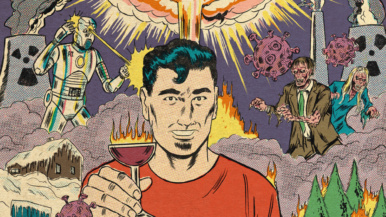This new art exhibit tackles the history of monstrosity
De Monstris, the latest exhibit at U of T’s Thomas Fisher Rare book Library, explores how the concept of monsters has evolved over the years. Curator David Fernández spent nearly five years gathering texts and artworks dating back to the 16th century, all of which explore how our fear and fascination with foreign beasts have influenced history, medicine, and exploration of the New World. Here are a some of the most captivating creatures on display:

Pliny, the Elder, born in 23 A.D., compiled illustrations of animals over the course of his life. He’d never seen any of these creatures in real life, so he modelled his sketches after ancient Greek and Roman texts. Hundreds of years after he died, they were published in an encyclopedia of natural philosophy, Historia natural de Cayo Plinio Segundo, and served as references for doctors and geographers. This edition, published in 1624, includes exotic birds and Arctic mammals from far-off countries, as well as indigenous peoples. Later editions described indigenous people as bestial and barbaric, and maligned Caribbean people as cannibals.

U of T’s edition of Giovanni Battista de’ Cavalieri’s 1585 book is one of only five copies left in the world, and the only one in the Americas. It depicts man-like figures with dog heads, who were said to eat humans and animals, and bird people with long necks. Years later, the Italian geographer Giovanni Botero reproduced these images in a travel book about Europe, Africa, Asia and the New World.

The Papal Ass was a monster with a donkey’s head, woman’s torso, an elephant trunk arm, hooves and a tail with a dragon’s head. The image was created by German printmaker Wenzel von Olmütz and used as propaganda during the Protestant Reformation in 16th-century Europe. Martin Luther wrote that the Papal Ass was “what God himself thinks of the papacy, which should horrify all who would take it to heart.” He used the image of this monster to lure people away from the the Roman Catholic Church.

As explorers discovered the New World in the 1600s, they sent back details about its inhabitants. In this 1655 image, depicting flesh-feasting cannibals, German theologian Johann Ludwig Gottfried recreated a sensationalized version of what he thought was happening in America.

This 1595 illustration of Iceland is considered to be one of the first geographically accurate maps. The creatures depicted here, including sharks and the mythical kraken monster, were thought to live in the sea, and were reimagined based on ancient myths, such as such as the 13th-century Scandinavian text The King’s Mirror.

Based Aristotle’s principles of zoology, bestiaries were books that contained images of animals both real and imagined. One of the most notorious monsters of the time was a manticore, a human-eating beast with the face of a person, body of a lion and the tail of a scorpion.

Throughout history, people with birth defects were labelled as beasts. Many people believed that a mother’s impure thoughts could transform her unborn fetus into a monster. In the late 1660s, the Italian physician and philosopher Fortunio Liceti began studying birth defects and created this image for a medical textbook, helping develop a scientific explanation for birth defects. “Every historical period has produced stories of monsters. They’ve been there alongside humans for as long as we’ve produced culture,” says Fernández. “Their history reveals so much about us as humans.”
De Monstris runs until December 21 at the Thomas Fisher Rare Book Library.





